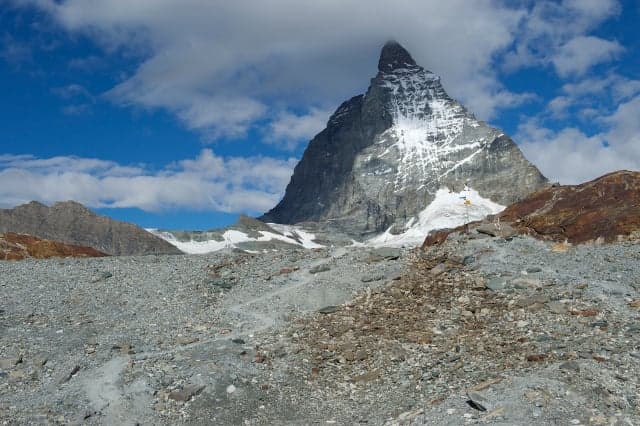Zermatt celebrates 100 years of Switzerland’s highest mountain cabin

On Tuesday the Swiss Alpine Club (SAC) and the village of Zermatt celebrate the 100th anniversary of the Solvay Bivouac, which sits at 4,003m on the Matterhorn.
Opened on August 8th 1917, the Solvay hut, as it is commonly known, is located on the Hörnligrat section of Switzerland’s iconic mountain and is the highest shelter in the country.
Unmanned, it is a simple structure that was designed primarily as a shelter for climbers in distress, for example those who may have been caught out by the weather and need a place to sit it out.
It was built in response to an increasing number of deaths and dramatic incidents on the famous mountain since it was first conquered by Edward Whymper in 1865.
The need for a shelter on that critical part of the mountain rapidly became clear, and it was made possible by Ernest Solvay, a Belgian chemist, climber and philanthropist who in 1904 donated 20,000 francs for its construction, a considerable amount of money at the time, in thanks for “all the pleasure that the high mountain has given me”, SAC said in a press release.
Not everyone was in favour, including mountain guides who felt the presence of the new hut may mean their services would no longer be required.
SAC fought against the objections and in 1912 finally gained approval from the authorities, on the proviso that the shelter could only be used in emergencies.
Building work eventually started in summer 1915 and was a precarious and complex process. Timber was transported on mules from Zermatt to the Hörnli hut, at the foot of the Matterhorn, and then hoisted a further 800 metres of elevation via a specially-constructed seven-stage winch system.
Despite the long, tiring days, the treacherous conditions and the ever-present risk of falling, none of the workers was killed and the shelter was completed in two months.
However due to bad weather, the cabin wasn’t inaugurated until two years later, on August 8th 1917.
Now, up to 600 climbers spend the night there every year, says SAC, however only around 40 of those do so because they are in an emergency situation.
Some choose to stay there because they want to avoid the cost of the Hörnli hut further down, or break up their ascent.
However the hut's premier purpose remains true, allowing those in distress to a place to shelter in safety, giving rescue workers the liberty of waiting for favourable weather conditions before they begin a rescue operation.
“We would have a lot fewer problems if the Matterhorn didn’t exist at all,” joked Bruno Jelk, a Zermatt rescue worker for 35 years, to SAC.
But it does, and during the course of a century the Solvay bivouac has helped limit those problems, giving climbers a lifeline on Switzerland’s iconic but temperamental mountain.
Comments
See Also
Opened on August 8th 1917, the Solvay hut, as it is commonly known, is located on the Hörnligrat section of Switzerland’s iconic mountain and is the highest shelter in the country.
Unmanned, it is a simple structure that was designed primarily as a shelter for climbers in distress, for example those who may have been caught out by the weather and need a place to sit it out.
It was built in response to an increasing number of deaths and dramatic incidents on the famous mountain since it was first conquered by Edward Whymper in 1865.
The need for a shelter on that critical part of the mountain rapidly became clear, and it was made possible by Ernest Solvay, a Belgian chemist, climber and philanthropist who in 1904 donated 20,000 francs for its construction, a considerable amount of money at the time, in thanks for “all the pleasure that the high mountain has given me”, SAC said in a press release.
Not everyone was in favour, including mountain guides who felt the presence of the new hut may mean their services would no longer be required.
SAC fought against the objections and in 1912 finally gained approval from the authorities, on the proviso that the shelter could only be used in emergencies.
Building work eventually started in summer 1915 and was a precarious and complex process. Timber was transported on mules from Zermatt to the Hörnli hut, at the foot of the Matterhorn, and then hoisted a further 800 metres of elevation via a specially-constructed seven-stage winch system.
Despite the long, tiring days, the treacherous conditions and the ever-present risk of falling, none of the workers was killed and the shelter was completed in two months.
However due to bad weather, the cabin wasn’t inaugurated until two years later, on August 8th 1917.
Now, up to 600 climbers spend the night there every year, says SAC, however only around 40 of those do so because they are in an emergency situation.
Some choose to stay there because they want to avoid the cost of the Hörnli hut further down, or break up their ascent.
However the hut's premier purpose remains true, allowing those in distress to a place to shelter in safety, giving rescue workers the liberty of waiting for favourable weather conditions before they begin a rescue operation.
“We would have a lot fewer problems if the Matterhorn didn’t exist at all,” joked Bruno Jelk, a Zermatt rescue worker for 35 years, to SAC.
But it does, and during the course of a century the Solvay bivouac has helped limit those problems, giving climbers a lifeline on Switzerland’s iconic but temperamental mountain.
Join the conversation in our comments section below. Share your own views and experience and if you have a question or suggestion for our journalists then email us at [email protected].
Please keep comments civil, constructive and on topic – and make sure to read our terms of use before getting involved.
Please log in here to leave a comment.